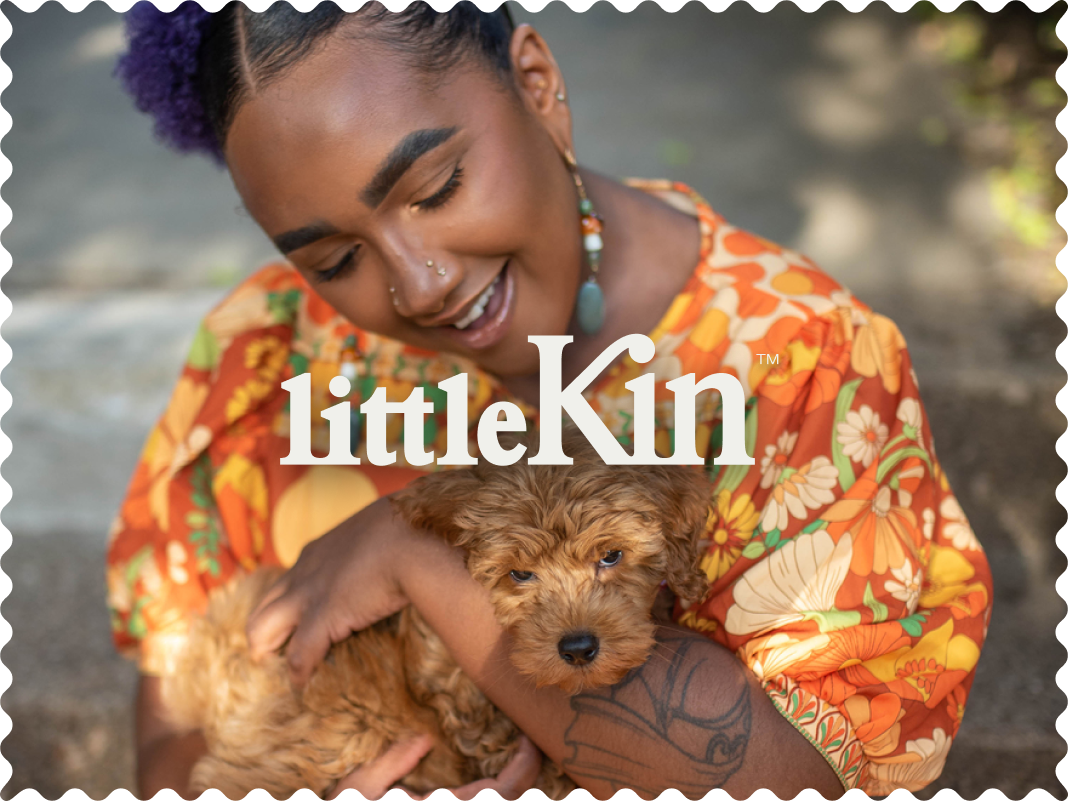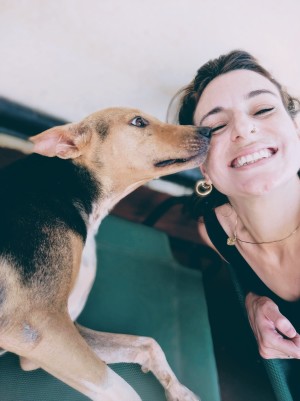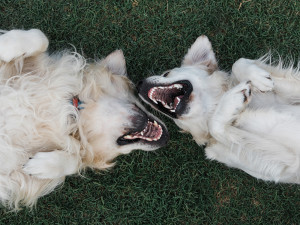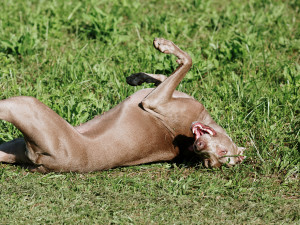Why You Should Be Washing Your Dog’s Toys (And How to Do It Right)
Because that slobbery plushie isn’t going to clean itself

Share Article
Every night after his dinner, my dog Sherlock sidles up to me, letting me know that he’s ready for our evening ritual of me throwing his beloved Mr Giraffey across the room. Recently, as I crouched down to grab the grubby Kong Wild Knots toy, I realised I’d never washed it; in fact, I’ve never washed any of my two dogs’ toys.
I scrub their bowls religiously, yet let them chew on festering plush and rope toys, ingesting who knows what. What germs could be lurking on Mr Giraffey? Are these pathogens the reason why my dog Lucy’s had a bad bellyopens in a new tab lately? Yikes.

littleKin™ is Kinship’s home just for puppy and kitten parents. Bop over to check out expert advice, new pet tools, and special deals—all curated for your newest family member.
opens in a new tabVowing to wash the toys in the morning, I wondered whether my laundry detergent was safeopens in a new tab to use on items that my dogs chew. So. Many. Questions. If you’ve also been shirking your hygiene duties too, fear not – I called on some experts to ask how often we should wash our dogs’ toys and how we should wash them…
How often you should wash your dog’s toys
My first port of call was Lucy Gorton, senior buyer at Pets at Homeopens in a new tab, who knows a thing or two about dog toys. She points out that while we should absolutely be washing our dog’s toys regularly, we don’t want to be cleaning them too much. Unsurprisingly for creatures that rate rolling in poo as a top hobbyopens in a new tab, dogs prefer their belongings on the grubbier side.
“ Dogs are naturally drawn to familiar scentsopens in a new tab, so from their point of view, the muddier and more well-loved, the better,” Gorton advises. “However, it’s all about finding the right balance between hygiene and the familiar scent your pet loves.
“As a general guide, frequency of washing depends on how often your pet uses the toys – if they become visibly dirty or develop an odour? It’s best to give them a clean.”
Eyeing the mini mountain of plushies, ropes and plastic bones on my living room floor in despair, I hit up Dr Edwina Gildea, vet and director of veterinary operations at Zoetis UKopens in a new tab for some specifics.
Rubber and plastic
“I recommend cleaning rubber or plastic toys at least once a week,” advises Dr Gildea. “If the toy is used to dispense food or treats, it should be washed after each use to prevent bacteria build-up.”
Plush/fabric
Dr Gildea says to wash plush toys every other week unless they’re a particular favourite. “In this case washing weekly is best, especially if your dog carries them in their mouth regularly, or sleeps with them,” she adds.
Rope
Ever noticed how grubby rope toys get? Turns out they’re a hotbed of grossness. “The fibrous texture of rope toysopens in a new tab makes them more likely to harbour bacteria, yeast and other nasties,” says Dr Gildea. “Weekly cleaning is especially important for these types of toys.”
Why you should wash your dog’s toys
In a 2012 studyopens in a new tab of the germiest household items, dog toys came up as the eighth grubbiest, showing high levels of staphylococcus and coliform bacteria, as well as yeast and mould. Ew.
“A dog’s mouth is full of germs that can spread to the toys, where they can replicate,” explains Dr Guy Sandelowsky, vet and co-founder of pet supplement company Omniopens in a new tab. “These harmful microbes can multiply and potentially make your dog sick.”
As well as the risk of gastrointestinal upset and internal infections, Dr Gildea warns that unwashed toys can also cause skin irritationopens in a new tab.
“Keeping toys clean is especially important if your dog suffers from skin conditions like atopic dermatitis,opens in a new tab” she explains. “This condition causes the skin to become more sensitive and reactive to allergens such as mould, dust mites and bacteria, which can easily build up on dirty toys.”
Best way to clean your dog’s toys
Rubber and plastic
Perhaps the easiest to clean, Gorton suggests handwashing rubber or plastic toys in warm, soapy water, ensuring any soap residue is thoroughly rinsed off. They can also be put on the top rack of the dishwasher (if labelled as dishwasher safe). “Use a hot water cycle to sanitise, with no detergent,” advises Dr Gildea. “Make sure to get into all the small crevices, particularly for food-related toys.” (Kong Classicopens in a new tab, we’re looking at you, you hard-to-clean beast).
Plush and/or fabric
For your dog’s fave plushie, check the care label – if it can be machine-washed, Dr Gildea recommends placing it in a mesh laundry bag and running a gentle cycle with hot water and pet-safe detergent (more on that later). If your dog’s BFF contains a squeaker, proceed with caution, warns Gorton: “Submerging them may affect the squeaker’s performance, so gently hand-wash these.”
Rope
As with plush and fabric toys, rope toys can be washed in the machine or by hand, using warm water and a pet-safe detergent.
However you clean your dog’s toys, air-drying is always the best option. If it’s a dry day, pop them outside to benefit from the natural disinfectant properties of the sun’s UV raysopens in a new tab, and always make sure they’re completely dry before giving them back to your pet.
To ensure your dog doesn’t have to wait in limbo for toys to dry, why not have their toy collection on rotation? While there’s not much research on dogs and their toys (fancy that?!), a small studyopens in a new tab back in 2008 showed that when given a choice, most dogs prefer new toys over familiar ones. However, this excitement is short-lived, so having a regular swap-out is a great way of keeping your dog stimulated.
Chemicals and products to avoid when cleaning dog toys
What makes a detergent unsafe for pets? Anything that contains harsh chemicals, according to Dr Sandelowsky. These include bleach, chlorine, artificial dyes and phthalates. “When used on dog toys, these can be ingested and damage their intestinal lining or cause toxicity,” he explains. “Heavily scented cleaning agents are also not ideal as they’ll smell much stronger to your dog and could put them off using the toy.”
Look for unscented non-bio detergents, or use soap nuts or a vinegar and bicarb soda mix. Add an extra rinse cycle to ensure there’s no remaining residue.
Can dogs share toys in a multi-dog household?
Thankfully, if your dogs are the sharing kind, it’s fine for them to share toys unless one of them is sick. “If your dog’s recently been ill, especially with sickness or diarrhoea, it’s a good idea to wash all their toys immediately,” advises Dr Gildea. Don’t forget to keep toys separate until they’ve recovered.
Special considerations
In certain cases, washing toys more frequently is advised, especially if your dog has gum diseaseopens in a new tab, eats poo (yum!), is immunocompromised or is on a raw food diet. FYI – salmonella from raw food can be spread via a dog’s salivaopens in a new tab, which could infect both you and other animals in the household. Puppies have weaker immune systems, so their toys should also be kept super clean.
When is it time to get rid of a dog toy?
All good things must come to an end, including dog toys. Weep. If a plush toy has ripped seams, protruding stuffing or a squeaker that’s coming out, it’s best to confiscate it to avoid choking or intestinal blockage. The same goes for any rubber or plastic toy that’s developed sharp edges. If your dog is ripping off and swallowing parts of the toy, it’s a sure sign to send it to the toy graveyard. Au revoir!
References
Berns, Gregory S., et al. “ Scent of the Familiar: An FMRI Study of Canine Brain Responses to Familiar and Unfamiliar Human and Dog Odors.opens in a new tab” Behavioural Processes, vol. 110, Jan. 2015, pp. 37–46.
Colclasure, Victoria J., et al. “ Coliform Bacteria, Fabrics, and the Environment.opens in a new tab” American Journal of Infection Control, vol. 43, no. 2, Feb. 2015, pp. 154–58.
Davies, R. H., et al. “ Raw Diets for Dogs and Cats: A Review, with Particular Reference to Microbiological Hazards.opens in a new tab” Journal of Small Animal Practice, vol. 60, no. 6, Apr. 2019, pp. 329–39.
Donofrio, Robert S., et al. “ Are We Aware of Microbial Hotspots in Our Household?opens in a new tab” Journal of Environmental Health, vol. 75, no. 2, Sept. 2012, pp. 12–19.
Kaulfuß, Patricia, and Daniel S. Mills. “ Neophilia in Domestic Dogs (Canis Familiaris) and Its Implication for Studies of Dog Cognition.opens in a new tab” Animal Cognition, vol. 11, no. 3, Jan. 2008, pp. 553–56.

Lisa Bowman
Lisa is a writer whose work has been featured in the likes of Stylist, Metro and The Guardian. She spends her days at a computer so she can bankroll her two rescue dogs, who may or may not be The Cutest Dogs in the World.
Related articles
![a picture of a whippet puppy on a big bed]() opens in a new tab
opens in a new tabHow Often Should You Really Wash Your Dog’s Bed? Experts React to TikTok Advice
I’m sorry, you’re supposed to wash your dog’s bed how often?
![a pair of English cream retriever dogs wiggle around on their backs with big grins on their faces]() opens in a new tab
opens in a new tab1 in 8 Dogs Has Dental Disease – Does Yours?
Here are four common dental problems your pup might face and how to treat them
![Woman with brown hair on hand and knees with yellow cleaning gloves on, cleaning the floor whilst a black Labrador watches on]() opens in a new tab
opens in a new tabPet-Safe Cleaning Products
Because we have to look after the four-legged family members, too
![Cute weimaraner dog lying on lawn and scratching its back]() opens in a new tab
opens in a new tab5 of the Best Ways to Solve Your Dog’s Allergies
Here’s what works (and what doesn’t)
![Bullmastiff puppy chewing on a purple ring chew toy]() opens in a new tab
opens in a new tab11 Tough Toys for Power Chewers
Veterinary behaviourist Dr Valli Parthasarathy recommends the most durable dog toys for destructive players




